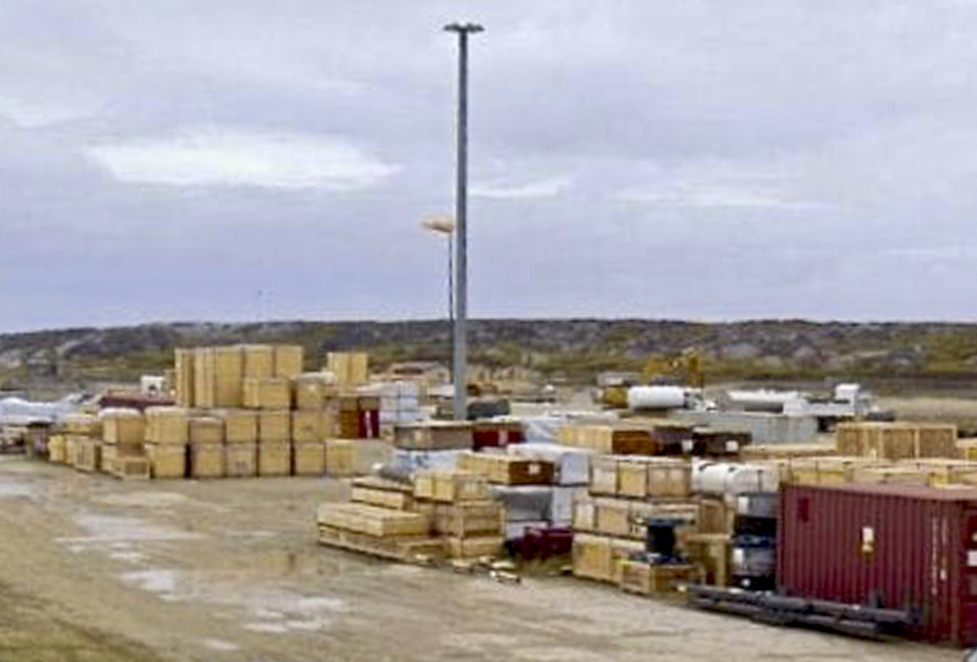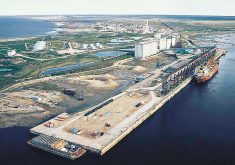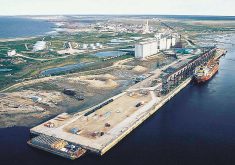It’s been decades since there’s been this kind of optimism about the Port of Churchill and how it could be developed as a transportation hub.
The money is flowing. On Feb. 23, Manitoba Premier Wab Kinew announced $60 million in provincial and federal funds to get the Hudson Bay Railway between The Pas and Churchill back up and running reliably, and to upgrade the port. That brings combined federal and provincial investment in the port to $293 million since 2018.
The new funding “means jobs will be maintained,” said Canada’s Northern Affairs Minister Dan Vandal.
Read Also

Seeding Indigenous agricultural prosperity
National Circle for Indigenous Agriculture and Food says Indigenous agricultural success needs strong relationships.
”This means mining and forestry opportunities will open up, including, of course, critical minerals, which are essential to our country’s north. Manitobans, through the Bay Line communities, will have the opportunity to position themselves as a true gateway to the Arctic and a true gateway to the world.”

For the agriculture sector, it’s a closer seaport than the Port of Vancouver.
Why it matters: Churchill is Manitoba’s only rail-accessed seaport, but positioning it as a major grain shipment destination faces hurdles.
Recent history of the port has been messy. The sole rail line linking Churchill with the rest of the province has been plagued by service disruptions. In 2018, the port and rail line were sold by U.S. company Omnitrax to a private-public entity dubbed Arctic Gateway Group, after Omnitrax said it was unable to shoulder the cost of rail repairs.
At the time, Churchill had been cut off from land transport for months due to flood damage to the tracks in May 2017.
The new owners included AGT Food and Ingredients, Fairfax Financial Holdings, Missinippi Rail Limited Partnership and a group of local communities. Those communities transitioned to full ownership in 2021.
Later in 2021, it was announced the port would take a two-year hiatus while rail tracks were rehabilitated.
Uphill battle
The high-water mark for Churchill’s grain shipments was reached in 2006, when 621,000 tonnes moved through its terminals. The port’s viability at that time depended almost completely on grain from the Canadian Wheat Board and wheat accounted for 90 per cent of traffic. After the CWB’s single desk selling authority ended in 2012, volumes began to slide. Operations ceased in 2015.
In 2019, following the sale of the port and rail line, grain shipments restarted amid much fanfare, only to fall prey two years later to the 2021 hiatus.
Churchill Mayor Michael Spence said grain traffic will return, but the port will be less reliant on a single commodity.
“We are a port community and one of the commodities that we all know has been historically shipped through the Port of Churchill is grain, but we will diversify. We will look at other products as well,” he said.
Hurdles for recovery
According to some experts, those “other products” will have to do a lot of heavy lifting and regaining grain traffic will not be easy.
“There’s a possibility it might never come back,” said Quorum Corporation president Mark Hemmes.

Quorum has been tapped by the federal government to monitor Canada’s grain handling and transportation system since 2001. Lack of interest from grain companies is a major obstacle.
“The big companies like Richardson, Viterra, P&H/Patterson and Cargill, they’ve all got facilities in Thunder Bay, Vancouver and Prince Rupert,” said Hemmes.
That makes Churchill less attractive.
Other issues include the northern port’s short season, higher insurance costs and a longer car cycle. The car cycle for grain cars going to Churchill is 20 days, Hemmes noted, compared to 15 for Vancouver and about 12 for Thunder Bay.
“You’re never going to get a 50-mile-an-hour track up there,” he said. “That’s not going to happen. You’re riding trains overtop of muskeg.”
Hemmes hasn’t travelled the Hudson Bay Railway, but he has travelled on other lines that pass over muskeg.
“If you’re in the middle of the summer and the top three or four feet of the road bed are now thawed, you can sometimes see the wave of the rail in front of the locomotive,” he said.
Kinew says shipping to Churchill makes a lot of sense for several agricultural areas.
“We know there’s a lot of interest for grain producers in The Pas area. There is a real desire to get goods to market here,” he said.
Barry Prentice, professor of supply chain management at the University of Manitoba’s Asper School of Business, said Kinew is correct, but interest doesn’t guarantee that grain will move through Churchill.
“We’re back to the commercial reality,” he said. “Where’s that grain being collected? Who’s collecting it and do they want to put it through Churchill?”
Self-sustaining Churchill
It’s likely the railway has never been self-sustaining, Prentice noted. A few years ago, he ran some basic numbers on what it would take for the line to stand on its own merit economically, based on data from the Canadian Railway Association on rail traffic and maintenance costs.
That exercise suggested the Churchill rail line would have to carry about two million tonnes of product each year and, looking back on record grain volumes in 2006, it’s likely the railway met that threshold. The first order of business now is to attract passenger and resupply trains.
That traffic is now moving and growing. At February’s funding announcement, Spence reported that resupply traffic has grown about 160 per cent in the last three years. There has also been talk of Churchill becoming a resupply hub for Nunavut.
However, the critical minerals sector is generating buzz among those with a stake in the port’s rebirth. The federal government defines critical minerals as “minerals that are essential to modern-day technologies, including renew- able electricity, batteries, electronics and electric vehicles.”
According to the provincial government, Manitoba’s geology includes 29 of the 31 minerals on Canada’s 2021 critical minerals list, including lithium, graphite, nickel, cobalt, copper and rare earth elements. It’s also a sector on the rise. It has attracted millions of dollars of federal investment into research, development and exploration through the Canadian Critical Minerals Strategy.
The Arctic Gateway Group negotiated a deal with Hudbay Minerals late last year to move 20,000 tonnes of zinc concentrate mined by Hudbay Minerals Inc. Spence expects that to start this summer.
But Prentice noted 20,000 tonnes amounts to just one shipload and is a far cry from what is needed for port self-sufficiency.
Oil, gas and energy
Kinew also suggested shipping hydrogen sourced from Manitoba’s hydroelectic power grid. That process would use hydroelectric power to separate hydrogen from water, which would then be converted to ammonia for easier transport.
Oil and gas are a more contentious possibility, but neither Kinew nor Spence are ruling it out. Both did say, however, that environmental considerations must be given their due in future operation.
It’s not the first time oil transport through the Port of Churchill has been raised. To make up for lost revenues after the end of the CWB gravy train, Omnitrax floated a plan to ship 300,000 barrels of Alberta crude oil in 2013.
The idea was met with derision from environmental groups. Manitoba’s NDP government at the time also decried the idea. Then-environment minister Steve Ashton was quoted by the Canadian Press as saying, “Our advice to Omnitrax would be, go back to the drawing board on this.”
But the port is under federal authority, and though the province could not stop the plan, Omnitrax scuttled it a year later.
In April 2022, during a speech in Winnipeg, federal Conservative leader Pierre Poilievre also extolled the virtues of getting Alberta oil to sea via Churchill.
Prentice said the Arctic Gateway Group could indeed ship petroleum products, but social acceptance is another matter.
“What I think they have to wrestle with a little bit is, are they going to be a tourist port or are they going to be a commercial, heavy, industrialized port?” he said.
It’s more about optics than the actual risk of environmental disaster, he suggested. Because the train moves so slowly through the area, there is little chance of oil car puncture if there was a derailment.
Thinking big
Potash from Saskatchewan has also been mentioned as a possible opportunity for the port.
“Certainly, the volume is there,” said Prentice. “But if you’re starting to move potash, you have to build a handling terminal to move it through.”
Aside from grain, just about any new commodity will require at least some infrastructure development.
“There’s no way for this to work without investment,” said Prentice. “If the willingness was there to spend whatever it takes to make it work, it would work.
“If we built a railway properly in the first place, you know, we wouldn’t be having this same conversation, because we wouldn’t be worrying about continuously spending money to keep it from sinking in the muskeg.”
Prentice also expects maintenance of the rail line will become even more difficult because the section of line from Gillam to Churchill is sitting on a frozen peat bog.
“As climate change continues, that will become more active all the time.”
He suggested it might be time to look for a new rail path that would run more on the bedrock of the Canadian Shield.
“If you want a permanent solution, you’ve got to spend money to get a permanent solution. If you want to keep putting on bandages, you can keep this thing limping along,” said Prentice. “I don’t think it can be self-sustaining without a pretty big investment of capital to get there.”
He sees potential for Churchill as a container port.
“When the Churchill rail line was built, the only thing we actually exported from Western Canada — the only thing that mattered — was wheat. We have a very diversified economy today and, if we’re going to live in the 21st century, things are moving by container.”
Containers could also help move more grain through the port.
Arctic Gateway Group did not respond to requests for comment as of press time.
















